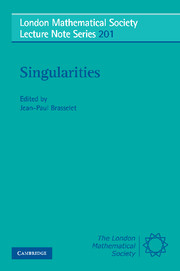Book contents
- Frontmatter
- Contents
- Introduction
- Plenary Conferences
- Specialized Conferences
- List of participants
- On Complex Projective Hypersurfaces which are Homology-Pn's
- Generic Geometry and Duality
- An arithmetical factorization for the critical point set of some map germs from C2 to C2
- Trivializations of stratified spaces with bounded differential
- Moduli for Singularities
- Conormal space and Jacobian modules: A short dictionary
- Weak Lefschetz and Topological q-Completeness
- Volumes and lattice points - proof of a conjecture of L. Ehrenpreis
- Connexions méromorphes
- Deformations of maps on complete intersections, Damon's Kv-equivalence and bifurcations
- Cycles évanescents et faisceaux pervers II: cas des courbes planes réductibles
- A Desingularization Theorem for Systems of Microdifferential Equations
- Topological Stability
- Boundary Fronts and Caustics and their Metamorphoses
- Quid des stratifications canoniques
- Irrégularité des revêtements cycliques
Moduli for Singularities
Published online by Cambridge University Press: 05 May 2013
- Frontmatter
- Contents
- Introduction
- Plenary Conferences
- Specialized Conferences
- List of participants
- On Complex Projective Hypersurfaces which are Homology-Pn's
- Generic Geometry and Duality
- An arithmetical factorization for the critical point set of some map germs from C2 to C2
- Trivializations of stratified spaces with bounded differential
- Moduli for Singularities
- Conormal space and Jacobian modules: A short dictionary
- Weak Lefschetz and Topological q-Completeness
- Volumes and lattice points - proof of a conjecture of L. Ehrenpreis
- Connexions méromorphes
- Deformations of maps on complete intersections, Damon's Kv-equivalence and bifurcations
- Cycles évanescents et faisceaux pervers II: cas des courbes planes réductibles
- A Desingularization Theorem for Systems of Microdifferential Equations
- Topological Stability
- Boundary Fronts and Caustics and their Metamorphoses
- Quid des stratifications canoniques
- Irrégularité des revêtements cycliques
Summary
Introduction
The aim of this article is to report on the authors' recent methods and results about moduli spaces for curve singularities and for modules over the local ring of a fixed curve singularity. We emphasize especially the general concept which lies behind these constructions. Therefore, the article might be useful to the reader who wishes to have the leading ideas and the main steps of the proofs explained without going into all the details. We also calculate explicit examples (for singularities and for modules) which illustrate the general theorems.
The construction of moduli spaces for certain objects means a geometric classification of the objects with respect to some equivalence relation. This is adequate, in particular, when it becomes too complicated to give a complete classification through (parametrized) normal forms. The basic concept, which stems from Mumford's Geometric Invariant Theory, is that of a coarse moduli space. Such a coarse moduli space for singularities respectively for modules over the local ring of a fixed singularity consists of a complex space or an algebraic variety M such that the points of M correspond in a unique way to equivalence classes of singularities or modules (with certain invariants fixed). Moreover, it is required that (flat) families of singularities or modules correspond to subvarieties of M. This means that the structure of M reflects neighbouring relations between objects which are given by small deformations.
- Type
- Chapter
- Information
- Singularities , pp. 119 - 146Publisher: Cambridge University PressPrint publication year: 1994
- 4
- Cited by



